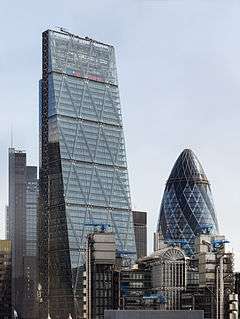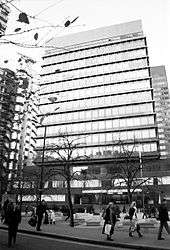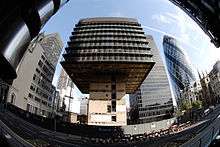122 Leadenhall Street
| Leadenhall Building | |
|---|---|
 The Leadenhall Building (with the Heron Tower and 30 St Mary Axe in the background and the Lloyd's building in front), viewed from the Monument in 2014 | |
| Alternative names | The Cheesegrater |
| General information | |
| Status | Complete |
| Type | Office |
| Architectural style | Post-modern; High-tech |
| Location |
London, EC3 United Kingdom |
| Completed | June 2013 |
| Opened | July 2014 |
| Cost | £286 million |
| Height | |
| Roof | 225 metres (738 ft)[1] |
| Technical details | |
| Floor count | 48 |
| Floor area | 84,424 m2 (908,730 sq ft) |
| Design and construction | |
| Architect | Rogers Stirk Harbour + Partners |
| Structural engineer | Arup Group |
| Website | |
|
www | |
| References | |
| [2] | |
122 Leadenhall Street, or the Leadenhall Building, is a 225 m (737 ft) tall building on Leadenhall Street in London. The commercial skyscraper, opened in July 2014, was designed by Rogers Stirk Harbour + Partners and is informally known as "The Cheesegrater" because of its distinctive wedge shape.[3] It is one of a number of new tall buildings recently completed or currently under construction in the City of London financial area, including 20 Fenchurch Street, 22 Bishopsgate, and The Scalpel.
The building is opposite the Lloyd's building, also designed by Rogers, which is the home of the insurance market Lloyd's of London.[3] Until 2007 the Leadenhall site was occupied by the P&O Tower (Peninsular and Oriental), a building owned by the developer British Land and designed by Gollins Melvin Ward Partnership that was completed in 1968 as a brother to the still existing Commercial Union tower, now called St. Helen's.[4][5] That building was demolished in preparation for redevelopment of the site. The project, initially delayed due to the financial crisis, was revived in 2010 and Oxford Properties co-developed the property in partnership with British Land.[6]
Site history
Prior to the site's previous redevelopment in the 1960s, it had been used as the head office of the Peninsular and Oriental Steam Navigation Company (P&O) for over a century. Since 1840, P&O had worked in the rent-free offices of Willcox & Anderson. However, business east of the Gulf of Suez increased in the late-1840s resulting in the company needing newer and larger offices. It was the P&O directors' obligation to provide new space. In November 1845, the King's Arms inn and hotel at 122 Leadenhall Street was put up for sale. The freehold was bought by P&O for £7,250, which then commissioned an architect, Beachcroft, to design a new building. The cost of the new building was estimated at £8,000. In March 1848, P&O moved into the new office.[7]
In 1854, P&O unsuccessfully attempted to purchase the neighbouring building at 121 Leadenhall Street, however they were eventually able to take a lease from the charity which held it. They also bought leases of 80 years from St. Thomas's Hospital on the residential properties at Nos. 123, 124 and 125 Leadenhall Street which were demolished to create a new frontage at No. 122. The new building provided more office space, some of which was for rent, and a spacious new courtyard.[7]
By the mid-1960s P&O needed to redevelop the site to provide increased office space again. At the same time, the Commercial Union Assurance Company was also planning a redevelopment on an adjacent site on the corner of St. Mary Axe. However, due to a number of issues affecting both sites, notably poor access to the Commercial Union site and the restricted width of the P&O site, it was not possible to obtain planning consents that would optimise the amount of floor space desired by either company. As a result, the two companies decided to participate in a joint development that would involve the reallocation of site boundaries and the creation of an open concourse area at the junction of Leadenhall Street and St. Mary Axe. Both companies would have frontages to the new concourse and would retain site areas equivalent to those enclosed by the original boundaries.
Previous building

When completed in 1969, the building at 122 Leadenhall Street was 54 m (177 ft) tall with 14 storeys above and three storeys under ground.[8] It was originally designed as a pair with the Commercial Union headquarters (now called St. Helen's) by the architects Gollins Melvin Ward Partnership. The two buildings have a central compressional concrete core and have suspended floors which hang using the steel 'chords' visible on the exterior of the building, which are hung from power trusses at the top of the building (and in the case of No. 1 Undershaft, a further central power-truss). It is an example of a tension structure; at the time, it was considered one of the most complex glass-fronted buildings in the United Kingdom. The architect acknowledged the influence of Mies van der Rohe.
The building was extensively damaged by an IRA bomb in the early-1990s and subsequently had to be reclad. It was occupied by various tenants until November 2006, including the Italian International Bank and Calyon.

In 2007–08, the building was demolished to make way for a new development. The demolition was undertaken by McGee Group Ltd, with Bovis Lend Lease acting as construction manager. The contract value was £16 million. The first phase of demolition was conventional: after securing the site, the contractors performed a soft strip of the interior and an asbestos survey prior to demolishing the low level structures up to podium level. After this, the suspended structure of the building required an unconventional demolition approach that successively dismantled each office floor from the lowest upwards. To achieve this, the contractors installed a structural deck that acted both as a work platform for the demolition work and as a safety barrier. This was jacked upwards as each successive office floor was removed. When all the office floors and upper support trusses had been removed, the concrete core was de-stressed and demolished. Concurrently, the 25,000 cubic metre basement was propped and excavated. The contract took just over two years to complete.[9]
The Leadenhall Building
Built by Laing O'Rourke, designed by Graham Stirk of Rogers Stirk Harbour + Partners and developed by British Land and Oxford Properties,[10] the new Leadenhall Building is 225 m (737 ft) tall, with 48 floors. With its distinctive wedge-shaped profile it has been nicknamed the Cheesegrater,[11][12] a name originally given to it by the City of London Corporation's chief planning officer, Peter Rees, who upon seeing a model of the concept "told Richard Rogers I could imagine his wife using it to grate parmesan. [The name] stuck."[13]
The planning application was submitted to the City of London Corporation in February 2004 and was approved in May 2005.[14] In 2006 Scheme Design (RIBA Stage D) started. In a statement made to the London Stock Exchange on 14 August 2008, British Land said it was delaying the project, which was due to start in October 2010.[15] On 22 December 2010, the developer announced the project was moving forward with contracts being signed for the 50/50 joint venture with Oxford Properties.[12]
The new tower features a tapered glass façade on one side which reveals steel bracings, along with a ladder frame to emphasize the vertical appearance of the building. It also appears to anchor the tower to the ground, giving a sense of strength. Unlike other tall buildings, which typically use a concrete core to provide stability, the steel megaframe, engineered by Arup, provides stability to the entire structure and is the world's tallest of its kind. The base features a 30 m high atrium. This will be open to the public and will extend the adjacent plaza. The flat side of the building is also encased in glass, and houses the mechanical services – in particular the elevator shafts. These have been turned into an architectural feature in a vein similar to the neighboring Lloyd's building – they deliberately show off the elevator machinery with bright orange painted counterweights and the actual elevator motors themselves.
This unusual design's main drawback is the building's relatively small floorspace (84,424 m²) for a building of its height. However, it is hoped that the slanting wedge-shaped design will have less impact on the protected sightline of St Paul's Cathedral when viewed from Fleet Street and the west.
The development is expected to cost approximately £286 million.[16]
In July 2011, British Land and Oxford Properties announced that Laing O'Rourke was the main contractor for the works of the new Leadenhall Building. Throughout 2011, construction began with the basement floors. By December 2012, the steelwork had progressed up to the fifth mega-level, with topping out expected in February or March. The glass cladding had also begun to rise. By June 2013, the steelwork of the building was completely topped out with the glass cladding covering almost half the building.
The construction of the building was the subject of an episode of the Super Skyscrapers documentary series by the American television channel PBS in February 2014.[17]
In November 2014 two bolts on the fifth floor failed in-service and dropped to ground level.[18] Following this, the bolts were tied to prevent bolt loss. A third bolt failed in January 2015, but was retained by the installed ties. The bolts were determined to have failed by a process known as hydrogen embrittlement.[19] Subsequently, further at-risk bolts were to be replaced [20]
Tenancy
The development has succeeded in attracting tenants, especially in contrast to the nearby part-built Pinnacle and completed Heron Tower. In May 2011, it was announced that the lower 10 floors of the Leadenhall Building have been pre-let to insurance broker Aon, which moved its global headquarters to London from Chicago.[21] Insurance group Amlin has also agreed terms on a 20-year lease of the 18th to 24th floors as well as the top floor — the 45th — from March 2015, for a total of 111,000 sq ft of office space.[22] The designers of the building, Rogers Stirk Harbour + Partners signed a 15-year lease on level 14, which will become their new head office. They will move in during 2015, having spent more than thirty years at Thames Wharf Studios, Hammersmith.[10]
See also
References
- ↑ "Planning Applications". City of London. 04/00111/FULEIA – Documents > South Elevation. Retrieved 6 December 2013.
- ↑ "The Leadenhall Building, London". skyscrapernews.com. 4 May 2014. Retrieved 4 July 2014.
- 1 2 Booth, Robert (13 August 2014). "Inside the Cheesegrater – London's latest skyscraper". The Guardian. Retrieved 18 August 2014.
- ↑ GMW Architects projects chronology 1960-1969
- ↑ GMW Architects projects P&O Tower
- ↑ "British Land and Oxford Properties Announce Completion of Joint Venture Agreement to Develop 610,000 sq ft Leadenhall Building". British Land. 22 December 2010. Retrieved 6 December 2010.
- 1 2 Freda Harcourt; Edward Harcourt, Sarah Palmer (2006). Flagships of Imperialism: the P&O Company and the politics of empire from its origins to 1867. Manchester University Press. ISBN 0-7190-7393-6.
- ↑ 122 Leadenhall Street at Emporis
- ↑ Case study McGee
- 1 2 "The Leadenhall Building to be RSHP's new home". Rogers Stirk Harbour + Partners. Retrieved 7 June 2015.
- ↑ "Building 49 – The Leadenhall Building". SkyscraperNews.com. 11 July 2007. Archived from the original on 5 August 2007. Retrieved 3 August 2007.
- 1 2 "British Land and Oxford Properties Announce Completion of Joint Venture Agreement to Develop 610,000 sq ft Leadenhall Building". Retrieved 23 September 2011.
- ↑ The Cheesegrater: Richard Rogers sprinkles the Square Mile | Art and design. The Guardian. Retrieved on 26 July 2013.
- ↑ "Planning Applications". City of London. 04/00111/FULEIA. Retrieved 6 December 2013.
- ↑ Hipwell, Deirdre (23 October 2010). "Canadians join British Land to build the 'Cheese Grater'". The Independent. London. Archived from the original on 24 October 2010. Retrieved 23 October 2010.
- ↑ E-architect: 122 Leadenhall Street
- ↑ Building the Future PBS. Retrieved: 12 February 2014.
- ↑ http://www.theguardian.com/business/2014/nov/05/cheesegrater-steel-bolts-fall-from-building
- ↑ "Cheesegrater to undergo repair work for 'embrittlement' after third huge steel bolt breaks off one of London's tallest skyscrapers".
- ↑ "cheesgrater bolts to be replaced".
- ↑ British Land pre-lets 10 floors of office space to Aon in the Cheese Grater building
- ↑ Insurer Amlin rents space in the Cheesegrater. Telegraph. Retrieved on 26 July 2013.
External links
| Wikimedia Commons has media related to 122 Leadenhall Street. |
| Wikimedia Commons has media related to P&O Tower. |
Coordinates: 51°30′50″N 0°04′56″W / 51.5138°N 0.0821°W